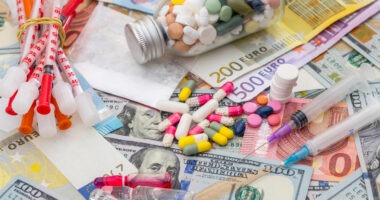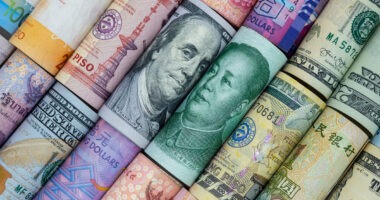Big Pharma’s Financial Performance: Ups & Downs
How have the bio/pharmaceutical majors performed thus far in 2022? Which companies and products are on the upside, and which companies and products are not meeting expectations? An analysis of first-half 2022 results and key progress of the top companies.
Roundup of first-half 2022: strong gains
Pfizer, Merck & Co., AstraZeneca, and GlaxoSmithKline were among the companies that reported double-digit growth in their first-half 2022 results compared to the prior-year period. Highlights below explain what was behind that growth
Pfizer. Pfizer reported first-half 2022 revenues of $53.4 billion, up 60% from its 2021 first-half 2021 revenues of $33.4 billion. Its key revenue contributors were its COVID-19 products: its COVID-19 vaccine, Comirnaty, and its oral antiviral drug to treat COVID-19, Paxlovid (nirmatrelvir tablets; ritonavir tablets), which accounted for approximately 60% of its first-half 2022 revenues. Comirnaty posted first-half 2022 revenues of nearly $22.1 billion and Paxlovid of approximately $9.6 billion. Among non-COVID-19 products, key revenue drivers were: Eliquis (apixaban), an anticoagulant, with first-half 2022 revenues of $3.5 billion; its Prevnar family of pneumococcal conjugate vaccines with first-half 2022 revenues of $3.0 billion; its breast-cancer drug, Ibrance (Palbociclib) with first-half 2022 revenues of $2.5 billion; and Vyndaqel/Vyndamax (tafamidis meglumine/tafamidis), a rare-disease drug to treat cardiomyopathy caused by transthyretin mediated amyloidosis with first-half 2022 revenues of nearly $1.2 billion. The company is projecting full-year 2022 revenues of between $98 billion and $102 billion.
Merck & Co. Merck & Co. also saw gains from a COVID-19 product and reported first half-2022 pharmaceutical revenues of $28.86 billion, up 50% from 2021 first-half pharmaceutical revenues of $19.22 billion. Key revenue contributors were: Keytruda (pembrolizumab), an immuno-oncology drug with first-half 2022 sales of $10.06 billion; Lagevrio (molnupiravir), an oral antiviral drug for treating COVID-19 with first-half 2022 sales of $4.42 billion; and Gardasil/Gardasil 9 human papillomavirus vaccines with first-half 2022 revenues of $3.13 billion.
AstraZeneca. Largely reflecting its $39-billion acquisition in July 2021 of Alexion Pharmaceuticals, a Boston-based bio/pharmaceutical company focused on rare diseases, AstraZeneca saw a 48% increase in its first-half 2022 revenues over the prior-year period to $22.16 billion. Total revenues from oncology products increased 22%, cardiovascular, renal and metabolism products increased 19%, rare-disease products 10%, and respiratory & immunology products 3%.
GlaxoSmithKline. GlaxoSmithKline (GSK) reported first-half 2022 revenues of £14.12 billion ($16.78 billion), a 25% increase at constant exchanges rates (CER), reflecting strong performance in specialty medicines (up 63% at CER) and vaccines (up 17% at CER) and relatively flat growth in general medicines (up 2% at CER).
Middle of the pack: moderate gains
Other companies reported more moderate revenue gains in the first half of 2022, with Sanofi, Lilly, AbbVie, Roche, and Bristol-Myers Squibb. Highlights below.
Sanofi. Sanofi reported first-half 2022 revenues of EUR 19.79 billion ($19.96 billion), an 8.4% increase at CER year-over-year. Its top-selling product was Dupixent (dupilumab), a drug for treating eczema, asthma, nasal polyps that result in chronic sinusitis, and eosinophilic esophagitis, an allergic condition that happens in the esophagus, with first-half 2022 sales of EUR 3.58 billion ($3.61 billion), a 44% gain year over year at CER. The company also saw strong gains in its specialty care products, which posted an increase of 19.8% over the first-half of 2021 to reach revenues of EUR 7.64 billion ($7.70 billion) in the first-half of 2022. On the downside, its general medicine products posted a 2.3% decline in first-half 2022 revenues to EUR 7.36 billion ($7.42 billion), and Lantus (insulin glargine), a drug to treat Type 2 diabetes, once the company’s top-selling product, continued to see revenue falls due to generic-drug incursion. The drug posted a 6.7% sales decline in the first half of 2022 to EUR 1.27 billion ($1.28 billion).
Eli Lilly and Company. Lilly posted first-half 2022 revenues of $14.30 billion, a 6% increase comparative to the prior-year period. Key revenue gains were for Trulicity (dulaglutide), a drug to treat Type 2 diabetes and Lilly’s top-selling drug with first-half 2022 revenues of $3.65 billion, up 22% year over year. The company also saw strong growth from its COVID-19 antibody drugs, which had first-half 2022 revenues of $1.60 billion, a 67% gain year over year. Other high-performing products were: Taltz (ixekizumab), a drug to treat certain autoimmune diseases (psoriatic arthritis, plaque psoriasis, ankylosing spondylitis, and axial spondyloarthritis) with first-half 2022 revenues of $1.09 billion (+13%); Verzenio (abemaciclib), a breast-cancer drug, with first-half 2022 revenues of $1.06 billion (+73%); and Jardiance (empagliflozin), a drug to treat Type 2 diabetes, with first-half 2022 revenues of $880 million (+32%).
On the downside, certain drugs had large revenue declines. Humalog (insulin lispro), a drug for treating Type 1/Type 2 diabetes, saw its revenues decline 13% in the first-half 2022 compared to the year-ago period to $1.06 billion, due to lower pricing for the drug. Alimta (pemetrexed), a drug for treating various cancers, had first-half 2022 revenues of $572 million, a 51% decline year-over-year, as it faces generic competition.
AbbVie. AbbVie had first-half 2022 revenues of $28.12 billion, a 4% gain year-over-year. Humira (adalimumab is AbbVie’s single largest product and accounted for approximately 36% of AbbVie’s total net revenues in the first-half of 2022 with revenues of $10.10 billion. It is the leading product in the company’s immunology franchise and has multiple indications in treating various diseases: arthritis, plaque psoriasis, ankylosing spondylitis, Crohn’s disease, and ulcerative colitis.
Other key revenue contributors were also part of AbbVie’s immunology franchise: Skyrizi (risankizumab), a drug for treating moderate-to-severe plaque psoriasis, active psoriatic arthritis, and moderate-to-severe Crohn’s disease, with first-half 2022 sales of $2.19 billion; and Rinvoq (upadacitinib) for treating moderate-to-severe rheumatoid arthritis, active psoriatic arthritis, moderate-to-severe ulcerative colitis, active ankylosing spondylitis, and moderate-to-severe eczema, with first-half 2022 sales of $1.06 billion.
Hematologic oncology is another important therapeutic sector for AbbVie, and its leading product is Imbruvica (ibrutinib) for treating various B cell cancers, including certain forms of lymphoma. It had first-half 2022 revenues of $2.32 billion, a 13% decline year-over-year due todecreased market demand and lower new patient starts in the US. Venclexta (venetoclax), a drug for treating chronic lymphocytic leukemia, small lymphocytic lymphoma, or acute myeloid leukemia, had a 16% increase in first-half revenues to $978 million.
Botox (onabotulinumtoxinA), which AbbVie gained with its approximately $63-billion acquisition of Allergan in 2020, had combined first-half 2022 revenues for cosmetic and therapeutic use of $2.63 billion, a 20% gain year-over-year.
Roche. Roche posted modest gains in its Pharmaceutical Division in the first-half of 2022 with sales of CHF 21.7 billion ($22.7 billion), an increase of 3% at constant exchange rates (CER). It had several products with double-digit sales gains year-over-year. These include Ocrevus (ocrelizumab) for treating multiple sclerosis, with first-half 2022 sales of CHF 2.91 billion ($3.04 billion) (+17%); Tecentriq (atezolizumab) for treating various cancers, with first-half 2022 sales of CHF 1.76 billion ($1.84 billion) (+11%); Hemlibra (emicizumab) for treating hemophilia A, with first-half sales of CHF 1.83 billion ($1.91 billion) (+30%); Kadcyla (trastuzumab emtansine), an antibody drug conjugate for treating breast cancer, with first-half 2022 sales of CHF 1.07 billion ($1.12 billion) (+14%); and Xolair (omalizumab) for treating asthma and chronic idiopathic urticaria (skin rash), with first-half 2022 sales of CHF 887 million ($927 million) (+11%).
Bristol-Myers Squibb. Bristol-Myers Squibb also had modest revenue gains in the first half of 2022, posting revenues of $23.54 billion, a 3% gain year over year. Key product revenue gains were from: Eliquis (apixaban), an anticoagulant, with first-half 2022 revenues of $6.45 billion (+14%); Opdivo (nivolumab), an immuno-oncology drug with first-half 2022 sales of $3.99 billion (+10%); Pomalyst/Imnovid (pomalidomide) for treating multiple myeloma, with first-half 2022 revenues of $1.73 billion (+7%); Orencia (abatacept) for treating rheumatoid arthritis, with first-half 2022 sales of $1.67 billion (+6%); and Yervoy (ipilimumab), an anti-cancer drug, with first-half 2022 sales of $1.04 billion (+8%).
Flat growth
Others saw relatively flat growth in the first half of 2022 compared to the first half of 2021. Highlights below.
Novartis. Novartis posted flat growth in the first half of 2022 with net sales of $25.3 billion (+0%, +5% constant currency [cc]) driven by volume growth of 12 percentage points, price erosion of 4 percentage points, and the negative impact from generic competition of 3 percentage points. Innovative Medicines, the company’s innovator pharmaceutical products, had net sales of $20.6 billion (0%, +5% cc).
Key revenue gains in its innovator products were from: Cosentyx (secukinumab), a drug to treat psoriasis, ankylosing spondylitis, and psoriatic arthritis and Novartis’ top-selling drug, with first-half 2022 sales of $2.43 billion (+9%, +12% cc); Entresto (sacubitril/valsartan) for treating heart failure, with first-half 2022 revenues of $2.22 billion (+32%, +37% cc); Promacta/Revolade (eltrombopag), a drug for treating low blood platelet counts due to persistent or chronic immune thrombocytopenia, with first-half 2022 sales of $1.02 billion (+5%, 10% cc); Zolgensma (onasemnogene abeparvovec), a gene therapy for treating spinal muscular atrophy, a rare neuromuscular disorder, with first-half 2022 revenues of $742 million (+17%, +22% cc), Ilaris (canakinumab) a drug to treat certain inflammatory diseases, with first-half 2022 sales of $560 million (+11%, +19% cc); Kisqali (ribociclib), a breast-cancer drug, with first-half 2022 revenues of $540 million (+30%, +36% cc); and Kesimpta (ofatumumab) for treating relapsing forms of multiple sclerosis with first-half 2022 revenues of $434 million (+274%, +280%).
The company saw declining revenues for two of its five top-selling products in the first-half of 2022 due to increased product competition. These were for Gilenya (fingolimod) for treating multiple sclerosis with first-half 2022 revenues of $1.16 billion (-19%, -15% cc) and Lucentis (ranibizumab), a drug for treating wet age-related macular degeneration diabetic macular edema, diabetic retinopathy with first-half 2022 sales of $1.02 billion (-7%, 0% cc).





